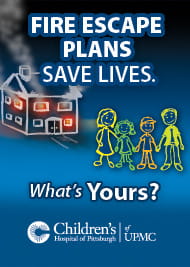 Fire is one of the most common home disasters and the third leading cause of accidental injury death at home. Fires spread very quickly – particularly in the winter months – but smoke and poisonous gases, not the flames, kill most fire victims.
Fire is one of the most common home disasters and the third leading cause of accidental injury death at home. Fires spread very quickly – particularly in the winter months – but smoke and poisonous gases, not the flames, kill most fire victims.
Every family needs to know what to do in the event of a home fire. Create a fire escape plan by identifying at least two exits from every room of your home. Teach your children to stay low when exiting the home to decrease smoke inhalation. Designate a meeting place that is a safe distance from the house and remind your children never to go back inside a burning house. Practice your escape routes two times each year. Practicing these fire-safe behaviors and knowing what to do in the event of a fire can save your life and the lives of your children.
What to do if there is a fire:
- Escape the building as quickly and as safely as possible.
- Feel a closed door to make sure it is not hot before opening it. If a door is hot or smoke is coming into the room from underneath the door, the fire may be right outside. Escape the room another way.
- If you can escape by the door, close it behind you.
- Leave personal belongings behind. Do not stop to gather valuables or memorabilia.
- Stay low to the floor and breathe through a cloth, if necessary, to avoid inhaling smoke.
- If your clothing catches fire, “Stop, Drop and Roll” to smother the flames.
- If you live in an apartment, escape by the stairs. Do not use the elevator. Take your house keys with you in case you cannot escape and have to return to your apartment.
- If you cannot escape your room, put wet towels or fabric at the bottom of the door to keep smoke out. Open the window and yell for help. Wave a sheet to attract attention. At night, wave a flashlight.
- After you escape, call “911” or the fire department from a neighbor’s house.
- Tell firefighters about any pets you may have left behind.
- Never re-enter a burning building once you have escaped.
- Meet your family members outside at a prearranged location, such as a street lamp or neighbor’s house.
Safety Tips
Help keep your family safe with these tips:
- Install smoke alarms on each floor of your house—including the basement, outside every sleeping area and in each bedroom.
- Test your smoke alarms once a month.
- Develop an escape plan to use in the event of a fire. Practice it with your family at least twice a year.
- Teach your children not to hide from fire and smoke.
- Teach your children how to “stop, drop and roll” if their clothing catches fire.
- Know two routes out of each room.
- Make sure windows work and are not painted shut. Know how to remove window safety guards.
- If you have to use escape ladders to exit through windows, practice using them.
- Designate a place for your family members to meet outside after a fire.
- Keep all-purpose fire extinguishers anywhere in your home that a fire might start, such as in the kitchen, garage, near the furnace and fireplace. Know how to use them.
- Be careful with flammables, such as matches and candles. Keep them out of the reach of children.
- Keep cooking areas clear of combustibles. Do not leave cooking food unattended.
- Make sure the electrical wiring in your house is safe. Do not overload outlets or run wiring under rugs.
- Put space heaters in an uncluttered area, with at least three feet of clear space on all sides.
- Careless smoking is the leading cause of fire in the home. Do not leave lit cigarettes/cigars unattended and never smoke in bed.
Learn more about the UPMC Mercy Trauma and Burn Center.









 Fire is one of the most common home disasters and the third leading cause of accidental injury death at home. Fires spread very quickly – particularly in the winter months – but smoke and poisonous gases, not the flames, kill most fire victims.
Fire is one of the most common home disasters and the third leading cause of accidental injury death at home. Fires spread very quickly – particularly in the winter months – but smoke and poisonous gases, not the flames, kill most fire victims.